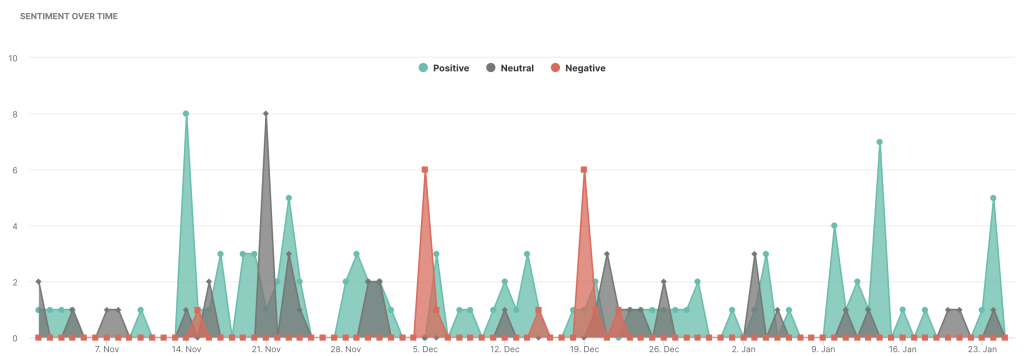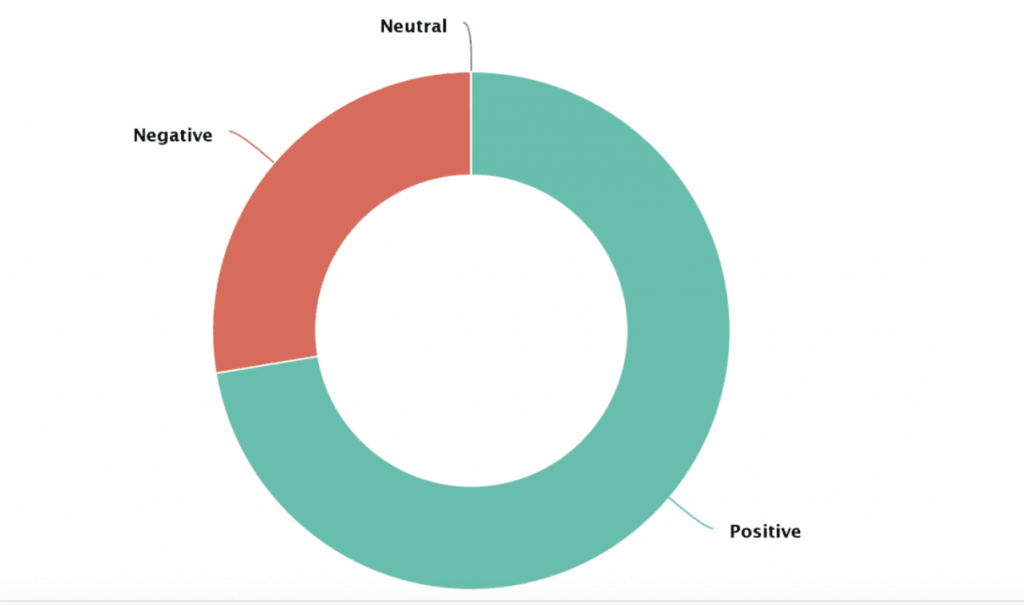Recently, social media sentiment analysis has played an essential role in US presidential campaigns.
Since people spend their time on social media these days, politicians need to keep an eye on their electorate there as well.
? Read Media Monitoring: The Ultimate Guide
As marketers, we’re interested in what people are saying about the brands on social media channels like Twitter and Facebook – so wouldn’t it be great to know what they’re saying about politics?
Let’s see how social media sentiment analysis can help your client during the next election.
How Does Social Media Sentiment Analysis Work?
? Social media sentiment analysis is the process of determining whether texts collected from social media are positive, negative, or neutral.
The method goes beyond counting comments, hashtags, or mentions. By analyzing sentiment, you can gain deeper insights into the opinions and emotions expressed in a message.
The sentiment score can indicate how users feel about politicians and their parties. Using this method, you can immediately know how the crowd is feeling. That way, you know whether some action needs to be taken to spark the discussion or calm it down.
Without it, you will not be able to respond to negative mentions, detect crises early and deal with them swiftly.
As an example, once you know the overall sentiment is negative, you can dig deeper into the issue to uncover what caused the negative bias.
Thus, you will be able to make better, more conscious decisions throughout the whole political campaign.
What Is the Role of Social Media Sentiment Analysis in Politics?
Public opinion polls tell us what voters think before they vote, but when it comes to today’s world – where public opinion shifts constantly – sentiment listening is an even more accurate predictor of voter activity.
Barack Obama’s victory in 2008 was not predicted by polls or media experts, thanks very much to a digital marketing campaign executed via social networking tools such as Facebook, YouTube, Twitter, MySpace, podcasts, and more (including many niche networks that are now dead).
It’s no longer surprising that a presidential candidate uses social media to build their brand. That’s why social media sentiment analysis has become even more valuable.
The role of social media sentiment analysis in politics is to look at the public’s opinions on political issues, as these opinions directly affect policies and drive elections.
But, it isn’t all sentiment analysis has to offer in politics.

Real-time insights
Voters’ moods can change at any point of the campaign, and it isn’t always clear what has happened.
Determ, for example, provides you with real-time sentiment analysis and even alerts you when there is an increasing buzz around your client’s brand.
Quick escalations
A speedy escalation system is another top benefit of sentiment analysis. As a result, potential issues are avoided or can be quickly resolved.
A better understanding of the voters
It’s hard to succeed in politics without fully understanding your electors. A clear message gets better results.
Sentiment analysis can be a secret weapon, not only for targeting the right demographics but also for monitoring the overall tone of the conversation.
Faster detection of changes
With social media sentiment analysis, you can monitor trends and see if overall opinion towards your clients is dropping or rising. By maintaining this awareness, you can increase political support.
Identification of key emotional triggers
Our emotions influence our decisions. By using sentiment analysis, you can identify what mentions and conversations affect audience mood.
7 Ways to Analyze Social Media Sentiment in Politics
1. Learn more about the voters
A political campaign is decided mainly by the people. So how do you know how your voter feels about your party or candidate? You probably have a private polling company that provides you with surveys and other relevant measures of public opinion, but what if there was a way to get a first-hand perception of the voters?
The answer is, of course, social media sentiment analysis. Using tools like Determ, you can track how a candidate’s sentiment changes and how their electors feel over time.

Apart from that, you can find out the demographical data around your mentions, gender to be more precise. This can influence your strategy in terms of setting riorites, changing your messaging, topics, etc.
Whatever you post on social media, each move you make leaves a lasting impression on your audience. When you use Determ, you can track and analyze it without any effort.
2. Analyze online reputation
The sentiment analysis of your social media content is a great way to build an effective communication strategy. Still, it also provides you with an opportunity to measure how people perceive the candidate.
Is your campaign image too aggressive? Are voters tired of the political discourse lately? To find out, analyze the sentiment breakdown, which shows how the sentiment is shaped.

Does negative sentiment dominate the breakdown? It’s time to determine why your client arouses unfavorable impressions (unfortunately, this industry is tricky to analyze because there are always people who disagree with the politician just because they vote for someone else).
3. Measure the public opinion about a certain topic
Another great thing about sentiment analysis is that it lets you get a detailed insight into public opinion regarding different political topics.
Get to know your voters’ opinions on issues related to education or healthcare, for example, and see how they feel about specific policy proposals. Then plan your campaign strategy accordingly by focusing on topics you are most likely to win.
4. Build a community of supporters
The people are the pillars of any political campaign, so you have to win their favor if you want success. People are involved in many activities now, so creating a community around a campaign is even more challenging.
Many political figures have used social media as a means to attract supporters and create a base of loyal voters. They have done this by providing content relevant to the community and keeping in touch with their supporters through different channels.
Sentiment analysis can help you discover the main topics your community wants to know about or how they feel about each other message.
Social media monitoring is also a great way to maintain high levels of engagement with the audience. By monitoring, you can respond quickly to all the comments, good or bad.
Furthermore, it is also possible to analyze sentiments of brand mentions across different channels and compare the number of mentions. Through this information, you can improve what and where you do to better engage your audience.
Taking the time to interact with the electors online, answering their questions, and addressing their concerns goes toward maintaining their support.
5. Watch the political opponents
Social media sentiment analysis lets you have an insight into the public image of your client’s opponents. Be aware of their online activity and discover what other people are saying about them so that you can plan your future moves accordingly.
In addition to benchmarking the number of your client’s mentions against competitors, you can also determine if the sentiment is positive or negative.
If you see your client’s competitor has a more significant number of positive mentions than their, you should look into it. Compare their social media strategy with yours and learn how to improve it.
6. Detect crises
If you want to avoid unpleasant surprises during the elections, staying in touch with voters and knowing how they feel about specific issues or events is essential.
Identifying a crisis early allows you to change your communication strategy quickly to solve the problem before it causes any harm.
It doesn’t work only during the political campaign. When an unexpected event occurs, such as a natural disaster, politicians tend to step forward and show their support for the victims. Having a monitoring tool will make managing the crisis much easier.
Using a sentiment analysis will help you find out how people perceive your client’s efforts and improve them if they fall short of people’s expectations.
It’s worth mentioning here that Determ provides real-time notifications to get you alarmed as soon as something unexpected happens.

In a matter of minutes, you can create an Alert – you can choose the method of notification you want to get or mute them for a certain time period.
7. Track the success of political campaigns on social media
The social media monitoring tool provides one more super powerful option – creating ready-made reports.
Reports in Determ are divided into primary, advanced, and competitive analyses (and you can even create your own customized dashboard).

Consequently, you can generate comprehensive data and statistics and analyze the overall success of a political campaign more effectively.
As a Final Note
Using social media sentiment analysis in politics, we can get a sense of the public mood on a specific topic. Analyzing what people are saying about your client can help you spot crises sooner and better manage the politician’s image.
Research of this type helps marketers identify trends and make better decisions based on public sentiment – ultimately leading your client’s political campaign in the best possible direction.
Looking to discover if any political opportunities are lurking around the corner? Book a call with one of our experts and see how much you can gain from monitoring social media in real-time.



